Canada is home to many wonderful things like maple syrup and hockey. Canada is also home to loads of spiders, and in this article, we will discuss 28 different types. All spiders are venomous, but that venom is for the insects they eat and not humans. Most spiders hate interacting with humans at all and would rather hide than ever have to defend themselves. Very few spiders in Canada are even slightly harmful to humans. You might be surprised to find that some of these Canadian spiders are pretty cute. Check out the list and see what you think.
1. Black Widow (Latrodectus mactans)
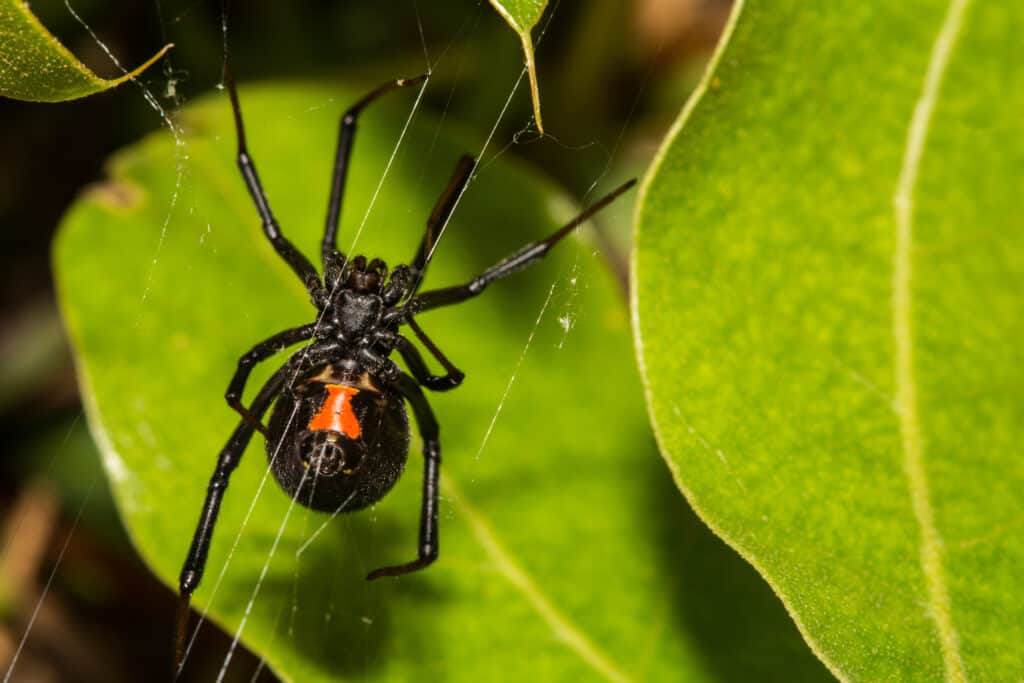
Black Widow spiders are feared for their venom, though very few people who are bitten are harmed.
©Jay Ondreicka/Shutterstock.com
Appearance: The Black Widow is a small, pea-sized black and red spider. Most commonly, they are seen in their adult form, a black body with a red hourglass on its underside.
Size: They are 1.5 inches long, including leg span.
Habitat: These little spiders are incredibly timid and prefer to make their asymmetrical and a bit sloppy webs in small crevices, boxes in attics or garages, under your home in the crawlspace, in outdoor toy bins, and other not frequented spots away from human contact.
Lifespan: Up to 3 years.
Danger: There is a vast looming stigma around these small spiders, and many people fear them. There is, however, little reason to be concerned. No one has died in over 10 years in the United States from a Black Widow bite. Any harmful side effects are rarely experienced, even when bitten more than once. However, they are medically significant.
Symptoms of Bitten: Once bitten, you may see some swelling and two puncture wounds at the site. Within 30 – 60 minutes after the bite, you may experience stomach cramping, achiness around the site, back pain, and pain in other extremities. If the muscle pain worsens or an elderly person or child is the victim, it’s best to head to the hospital for evaluation. Antivenom rarely needs to be used. Always practice safety and seek medical attention even if you don’t think you need it.
2. Yellow Sac Spider (Chiracanthium inclusum)

The Yellow Sac Spider is called such due to the flat sac-like webs they make to sleep in.
©Rainer Fuhrmann/Shutterstock.com
Appearance: The Yellow Sac Spider can be pale yellow to bright green with dark paws. Their mouth and eyes have a brownish color around them. Depending on what they have been eating, they can vary in coloring. If they eat something bright green, they become bright green. Those that have eaten red-eyed fruit flies turn a rosy hue.
Size: They are around 6mm or about the size of a nickel.
Habitat: They prefer the safety of the corners of ceilings or walls. They are nocturnal and stay in small flat silk sacs during the day. They also like gardens and foliage for their homes.
Lifespan: 1 – 2 years.
Danger: These spiders are slightly more aggressive than others and can bite more than once if trapped in your clothing or bed sheets. They only bite out of defense, like all spiders. Some say that the spider can bite and produce a skin-necrotizing effect. This has yet to be proven.
Symptoms of Bitten: Any bad symptoms will rarely arise, but if so, they can be systemic; fever, nausea, malaise, stomach cramps, or skin necrosis can occur. After about eight hours, a small pus-filled center may develop on the red bite. The dead skin will come off naturally, and the wound should be continued to be kept clean so as not to pick up a bacterial infection on top of the bite. Most of the time, the yellow sac spider’s bit will only cause a small reddened, hard bump that will go away on its own.
3. Carolina Wolf Spider (Hogna carolinensis)
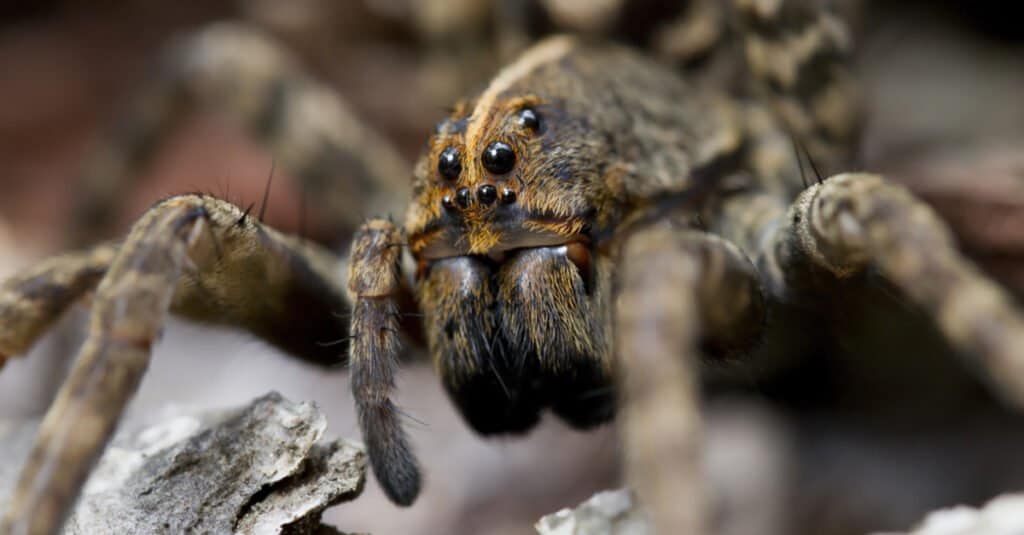
The Carolina
Wolf Spider
can reach nearly four inches long with its legs extended.
©Will E. Davis/Shutterstock.com
Appearance: The male Carolina Wolf Spider has orange coloration on the sides of their abdomen, making them reasonably easy to recognize. The females and males are commonly brown with markings of a darker shade on their backs. Some have been seen that are grey or tan. on
Size: The female Carolina Wolf Spider can reach 1 inch in body length and 4 inches in leg span, making this the largest wolf spider in North America. The males are 25% smaller than the females.
Habitat: These spiders prefer to live on flat open ground in the grass and rocks, such as fields or meadows. They dig burrows like tarantulas to use as their home. Sometimes they come inside but prefer the outdoors.
Lifespan: The female wolf spider can live up to 3 years, while the males typically only live 1 year.
Danger: These spiders are harmless, but their bite can be painful. If you are allergic to their venom, the symptoms warrant a hospital trip.
Symptoms of Bitten: There might be pain at the bite site and an itchy swollen area can appear. The bite goes away within a couple of days if left alone. Avoid scratching it because you can break the skin and introduce infection-causing bacteria. Wash the bite with soap and water and leave it alone.
4. False Widow (Steatoda grossa)

The False Widow does not have an hourglass shape on the underside of its abdomen.
©Dan Olsen/Shutterstock.com
Appearance: The false widow looks almost identical to the black widow, except it is brown or very dark purplish-brown and has no hourglass on its underside. They are commonly known as cupboard, comb-footed, or brown house spiders. These spiders originated in Europe.
Size: The false widow is a 1/4 – 1/2 an inch in length, and their leg span is approximately 1 inch.
Habitat: They prefer dark corners in homes, barns, sheds, crawlspaces, or attics. They sometimes make nests in cupboards, where their nickname, “the cupboard spider,” came from.
Lifespan: The females live up to 3 years, and the males live for 1 year.
Danger: These spiders are still considered medically significant since their bite is so painful. They are, however, harmless.
Symptoms of Bitten: If bitten, you may have a fever for up to a couple of days. The bite site may be harrowing and can become garnished with blisters. Clean it with soap and water and leave it alone. Within a few days, it will go away.
5. Striped Fishing Spider (Dolomedes scriptus)
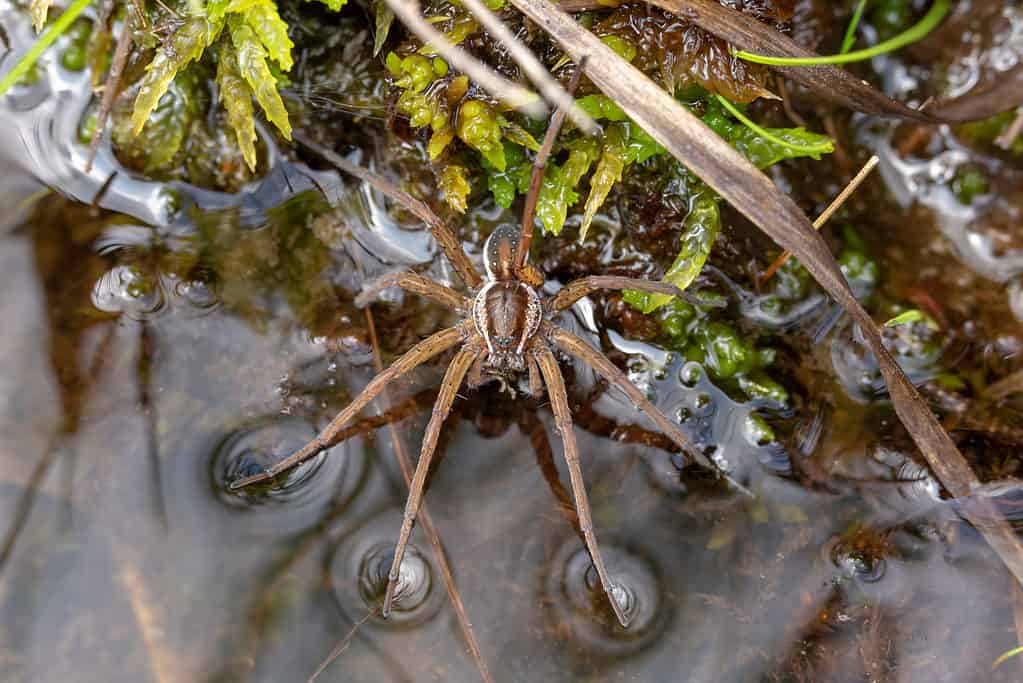
Raft spider (fishing spider) prefers to hunt along the water’s edge for small insects or minnows.
©iStock.com/Jordon Sharp
Appearance: The fishing spider is a leggy brown and grey spider. The legs are tapered and appear different from other spiders’ legs, which is an excellent way to identify them. These are pretty spiders with white, brown, grey, and black zigzags on their legs that look and act as camouflage. The spider’s body is also brownish-grey and has white or beige sides to its abdomen.
Size: The females’ body is 13 – 26 mm (half to 1 full inch), and the males’ body is 7 – 13 mm (a quarter to half an inch) in length. Their leg span is up to 2.5 inches.
Habitat: They are generally found near permanent bodies of water, along docks, bridges, wood, or on rocks near the water.
Lifespan: The females live between one and three years, and the males only live one year. The females typically kill the males after mating.
Danger: They are harmless, and bites very rarely happen.
6. Long-Bodied Cellar Spider (Pholcus phalangioides)
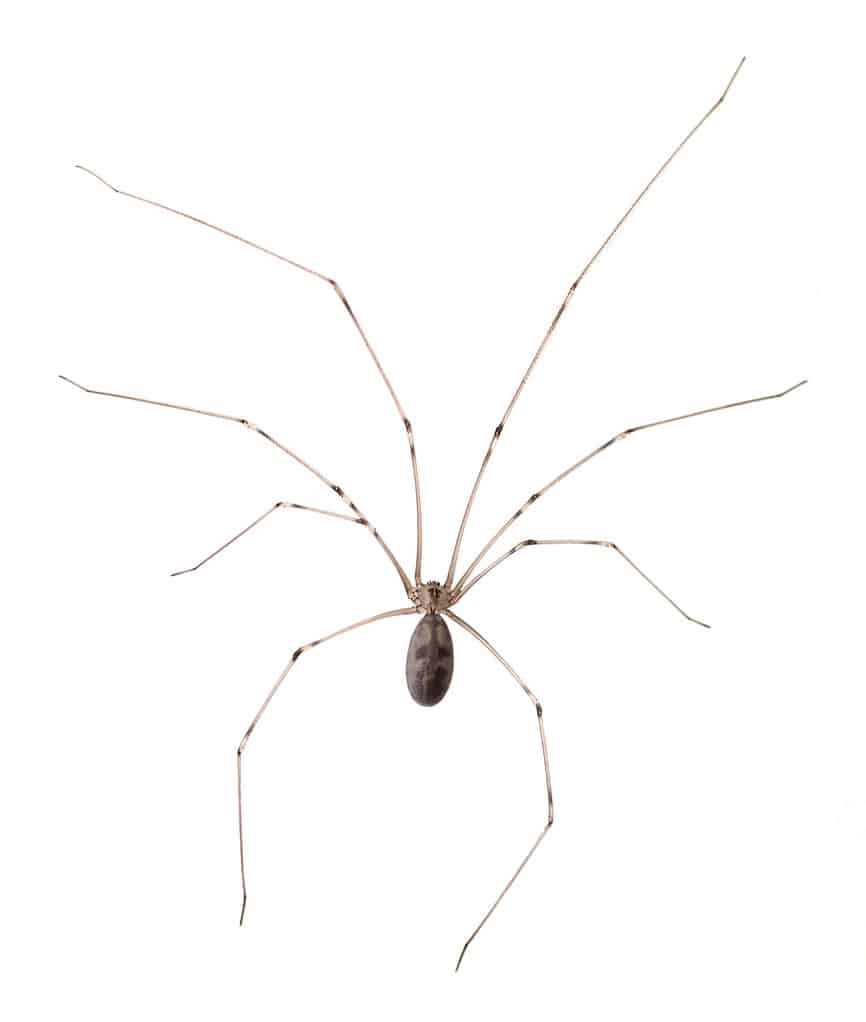
The Long-Bodied Cellar Spider is sometimes called a Daddy Long Leg, though they are two different creatures.
©Melinda Fawver/Shutterstock.com
Appearance: The long-bodied cellar spider is a tiny spider made to look large by its thin, long legs. Their body is oval-shaped, and their coloring can range from pale yellow to grey or brown.
Size: Their body size is 1/4 to 5/16 of an inch long with a leg span of approximately 2 inches.
Habitat: As their name suggests, these dark dwellers enjoy cellars, basements, crawl spaces, garages, caves, under rocks, and sheds. They are timid and tend to avoid places with human traffic.
Lifespan: They mature at 1 year old and can live for 3 years.
Danger: These spiders are harmless to humans. All spiders have venom, but it is specific to insects, not humans.
7. Dock or Wharf Spider (Dolomedes tenebrosus)
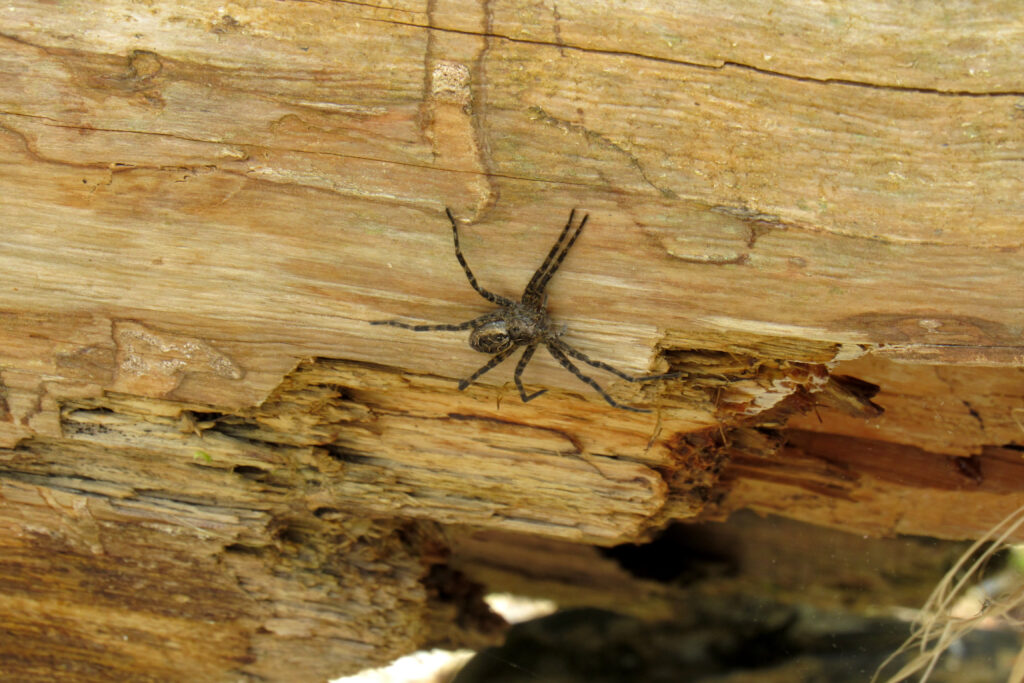
The Dock Fishing Spider is also called the Dark Fishing Spider because it is one of the darker-colored fishing spiders.
©Bailey Davenport/Shutterstock.com
Appearance: As another fishing spider, these look similar to the striped fishing spider but tend to be more brown and grey without white stripes on the legs or body. They have brown and grey striped legs to blend in with the ground. They are also called the dark fishing spider since they appear darker than the striped fishing spider.
Size: The female’s body can reach 1 inch in length and 3 inches in leg span. The males are nearly half the size of the females.
Habitat: They prefer to live near permanent bodies of water around docks, bridges, wood, and rocks.
Lifespan: The females can live up to 3 years, whereas the males only live for 1 year.Danger: The bite from the dark fishing spider can be painful and similar to a wasp sting, but it is not medically significant. The females may attack if harassed, like most other spiders.
8. Hobo Spider (Eratigena agrestis)
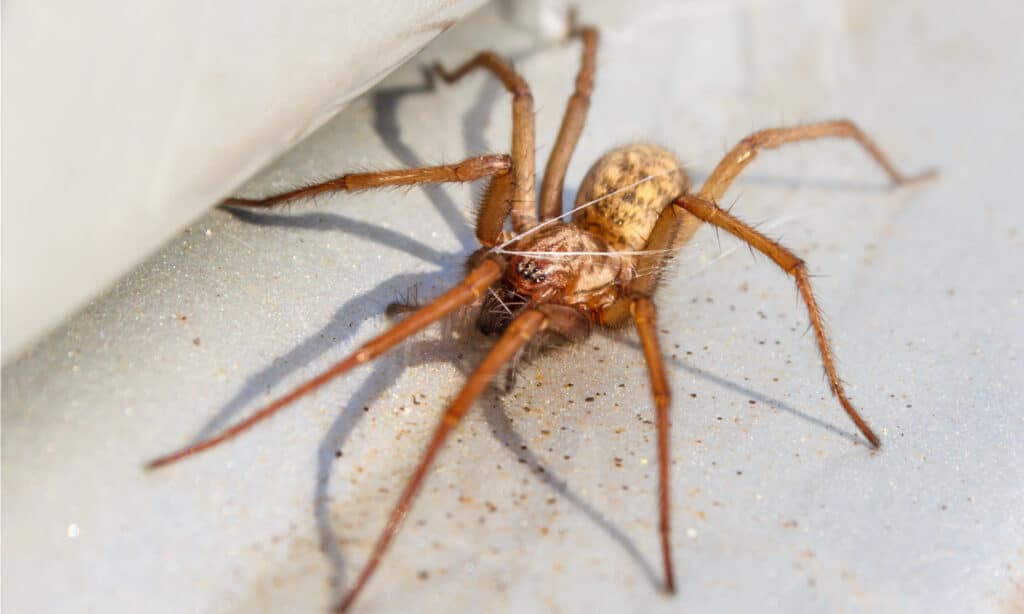
The Hobo Spider is named for its meandering when seeking prey or a mate.
©Andrew Balcombe/Shutterstock.com
Appearance: The Hobo Spider has very long legs, which help it obtain speeds of 17 – 40 inches per second. They have brown cephalothorax and yellowish markings on a grey abdomen with dark-colored legs.
Size: The females are 1/2 inch in body length, and the males are 1/4 inch. Their leg span can be up to
Habitat: They prefer to live in retaining walls near tall grass, piles of wood or rocks, or crevices in soil or concrete where they can make their funnel webs. Sometimes these spiders make their way inside and end up stuck in bathtubs because they cannot climb the smooth surface and are predominantly ground spiders.
Lifespan: 1 – 3 years.
Danger: People fear the Hobo Spider because it is rumored to cause tissue necrosis around the bite, but this is only seen in rare cases. Only one report named this spider the cause of a necrotic wound, and the person with the bite already had an underlying condition known to cause necrotic wounds. The spider’s bite is harmless.
Symptoms of Bitten: The bite will be red and possibly swollen. You may get a headache that isn’t responsive to painkillers and have a numb spot where the spider bit you.
9. Giant House Spider (Eratigena atrica)
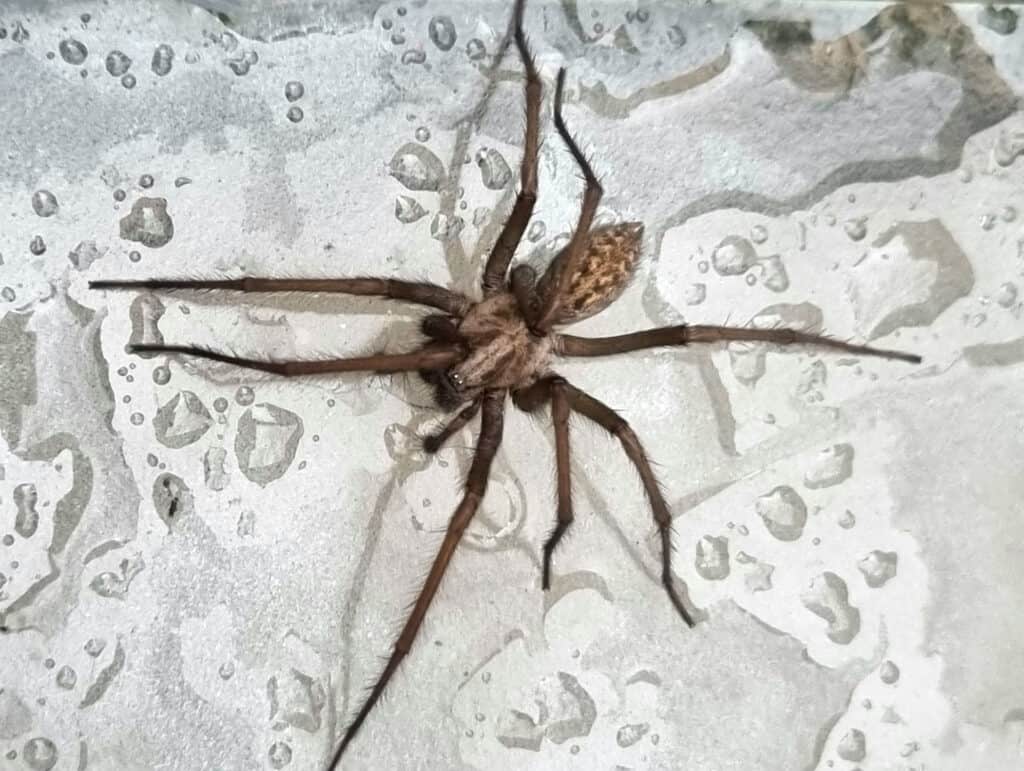
Close-up image of a giant house spider (Eratigena atrica) in raindrops on glass.
©iStock.com/Kelly McCutcheon
Appearance: They have dark brown hairy legs, a lighter brown or tan body with dark brown markings on their abdomen.
Size: The average leg span of a female is 1.8 inches, but they can reach close to 4 inches. Their body length is 3/4 inch, with the males being smaller.
Habitat: As their name states, these spiders prefer to live indoors and even kill Hobo Spiders when they enter. They are funnel weavers and prefer corners of your rooms, caves, or under rocks.
Lifespan: Up to 6 years
Danger: They are not dangerous to humans and will run when they see one. They are very timid and tend not to bite.
10. Furrow Orb Weaver (Larinioides cornutus)
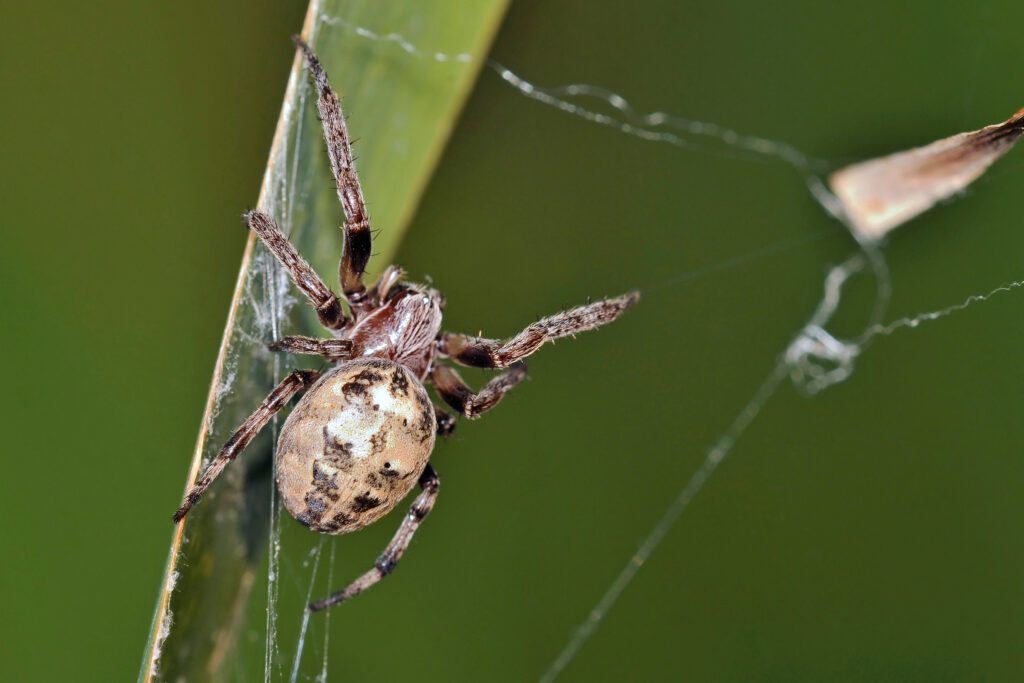
Furrow orb-weavers are common spiders to find in homes and on porches.
©ASakoulis/Shutterstock.com
Appearance: These spiders are small and tan-colored with darker striped legs and a dark brown lengthwise design on their abdomen.
Size: These spiders are small at 1/2 inch or less in length and up to 1.5 inches in leg span.
Habitat: They are typically found in moist areas near bodies of water. They build their webs between grass or low shrubbery.
Lifespan: Up to 1 year
Danger: They are not medically significant, and though they have venom like all spiders, it is harmless to humans.
11. Bold Jumping Spider (Phidippus audax)

The Bold Jumping Spider possesses excellent eyesight and leaping abilities, which it relies on to catch its small insect prey.
©Mircea Costina/Shutterstock.com
Appearance: These small, black, and white fuzzy spiders have two large forward-facing eyes like all jumping spiders, fuzzy pedipalps, colored cherished, or teeth, and can jump many times the length of their bodies. Males and females have white markings on their abdomen though sometimes it can be orange-tinted.
Size:1/4 – 1/2 inch body length and a leg span of up to 1 inch. The males are smaller than the females.
Habitat: They like to make tiny hammocks to sleep in up high in bushes, trees, on the sides of houses, and fences. They hunt their prey on the ground or in trees during the daytime.
Lifespan: 1 – 3 years
Danger: They are medically insignificant and very rarely bite. They will jump to escape danger and hide.
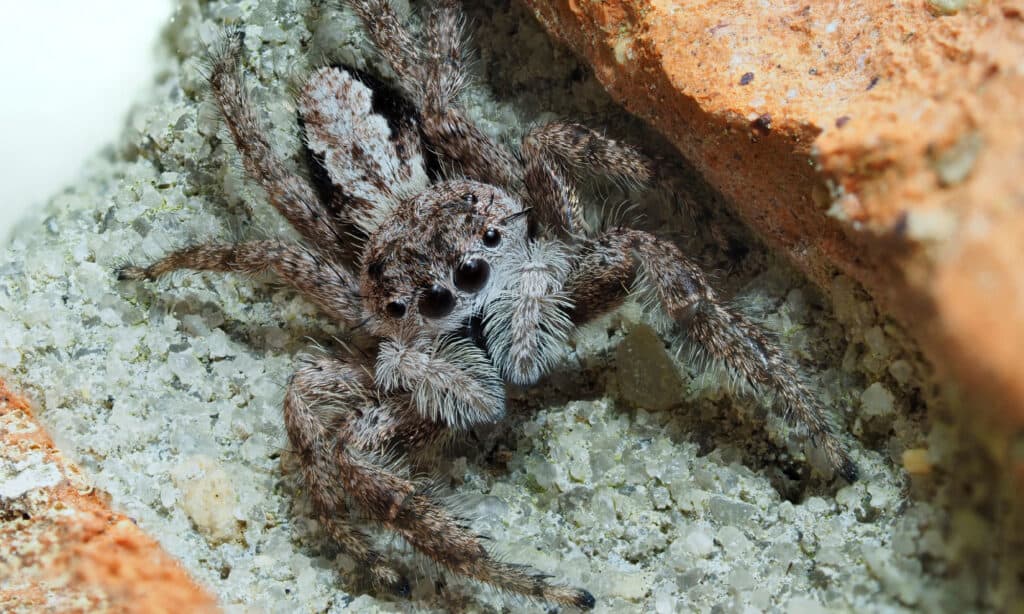
The Tan Jumping Spider has keen eyesight and an excellent jumping ability to hunt tiny insects.
©iStock.com/sdbower
Appearance: They are small greyish-tan fuzzy-bodied spiders with equally as fuzzy pedipalps.
Size: 1/4 – 1/2 inch in body length and a leg span of 1/2 inch or slightly larger. The males are on the smaller side.
Habitat: They prefer sides of houses, tree bark, bricks, fences, or porches.
Lifespan: 1 – 3 years
Danger: They are medically insignificant and rarely bite.
13. American Grass Spider (Agelenopsis sp.)
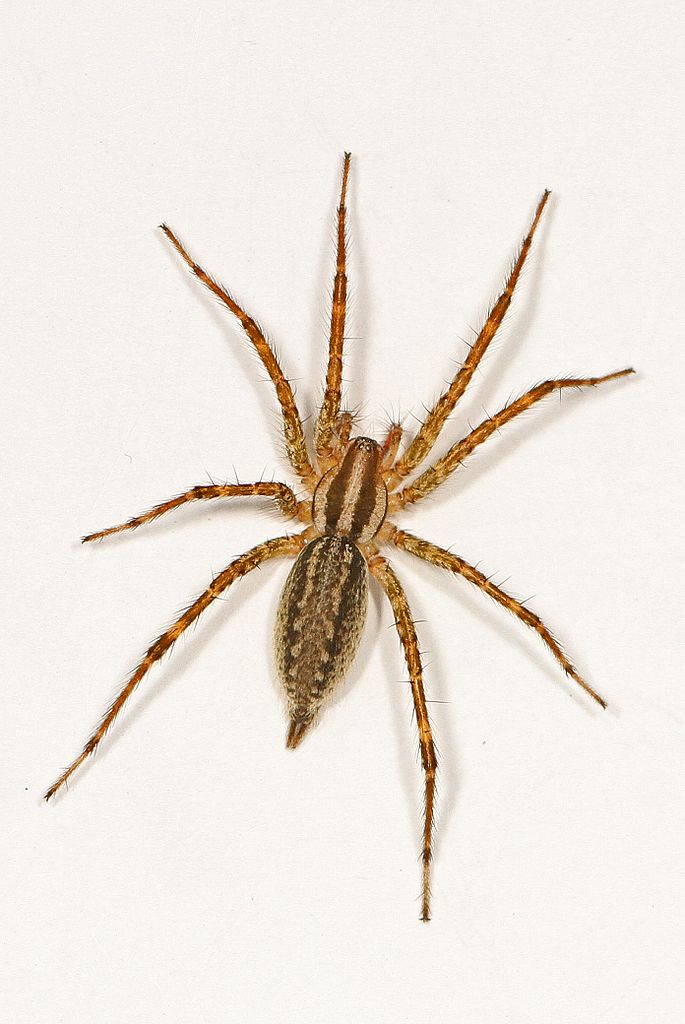
The harmless American grass spider is one of the most common spiders in the United States
©Judy Gallagher, CC BY 2.0 – License
Appearance: Yellowish-brown striped legs and a tan body with dark brown lengthwise stripes. These are very fast-moving spiders.
Size: Generally, 1/2 inch in body length and 1.5 inches for the leg span.
Habitat: As their name suggests, they build small funnels in the grass or between fences. They are also responsible for the sheet-like webs you see on top of the grass.
Lifespan: Up to 1 year
Danger: Not medically significant. Most of the time, the spider’s fangs cannot pierce human flesh unless it belongs to the elderly or a child.
14. Yellow Garden Spider (Argiope aurantia)
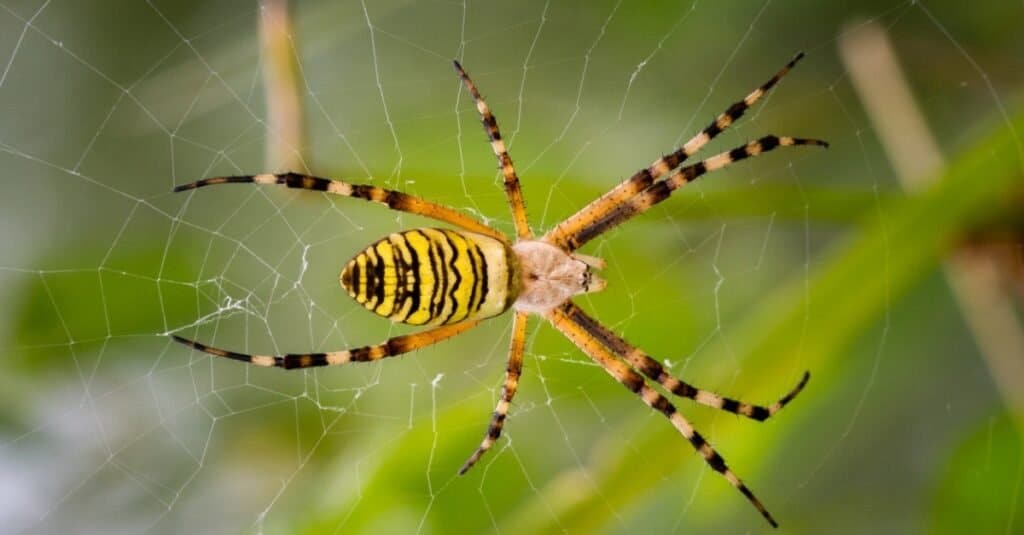
Yellow
Orb Weaver
in her web in the garden. They may seem big and scary but are peaceful beings.
©Denis Vesely/Shutterstock.com
Appearance: The female has distinctive yellow and black stripes along the abdomen and a skull-like face. The males are petite and amber-colored.
Size: Males are .2 – .35 inches long, which is much smaller than the female at .75 – 1.10 inches. The female’s leg span can reach
Habitat: They build webs adjacent to meadows and sunny fields that are out of the rain, wind, and sun. They also make webs along the eaves of homes and outdoor buildings.
Lifespan: 1 year
Danger: Their bite is not medically significant and poses no threat unless you are allergic.
15. Woodlouse Spider (Dysdera crocata)
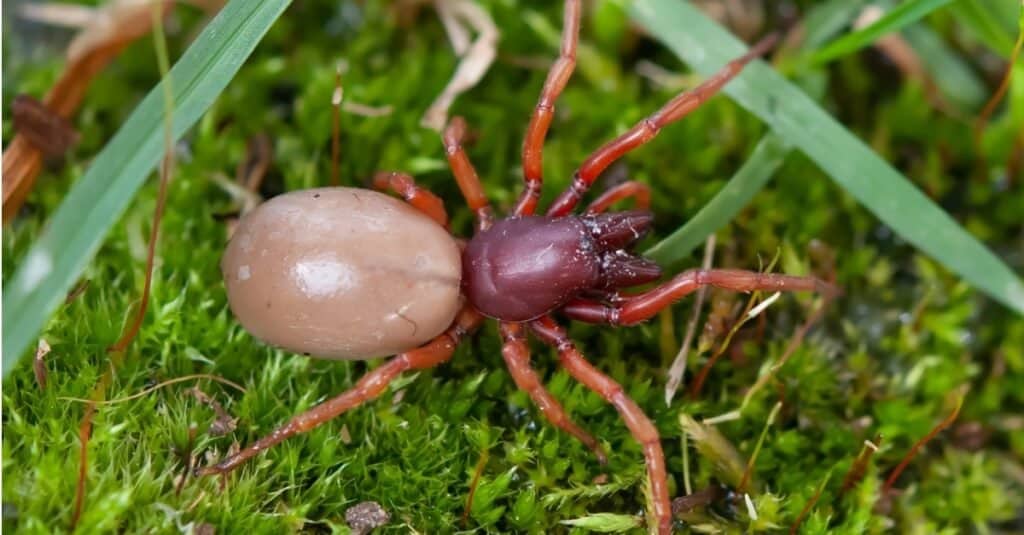
Red and orange
woodlouse
spider walking on green moss searching for its favorite food; woodlouse.
©iStock.com/Uwe Lubjuhn
Appearance: The Woodlouse Spider only has six eyes compared to the eight spiders generally have. Their cephalothorax is orangish-red, and their abdomen is anywhere from a pale beige to a dark grey. They also have segmented legs and oversized chelicerae.
Size: Approximately 1/2 inch long with a leg span of close to 1 inch
Habitat: These spiders prefer to hide in leaf litter or wood on the forest floor that might be close to their prey; woodlice. They spend the day inside crevices sealed with silk. They sometimes make tent-like structures between wood or rocks to sleep in.
Lifespan: They mature at 1.5 years and can live up to 4 years.Danger: They are harmless to humans, and their bite is not medically significant.
16. Eastern Parson Spider (Herpyllus ecclesiastics)
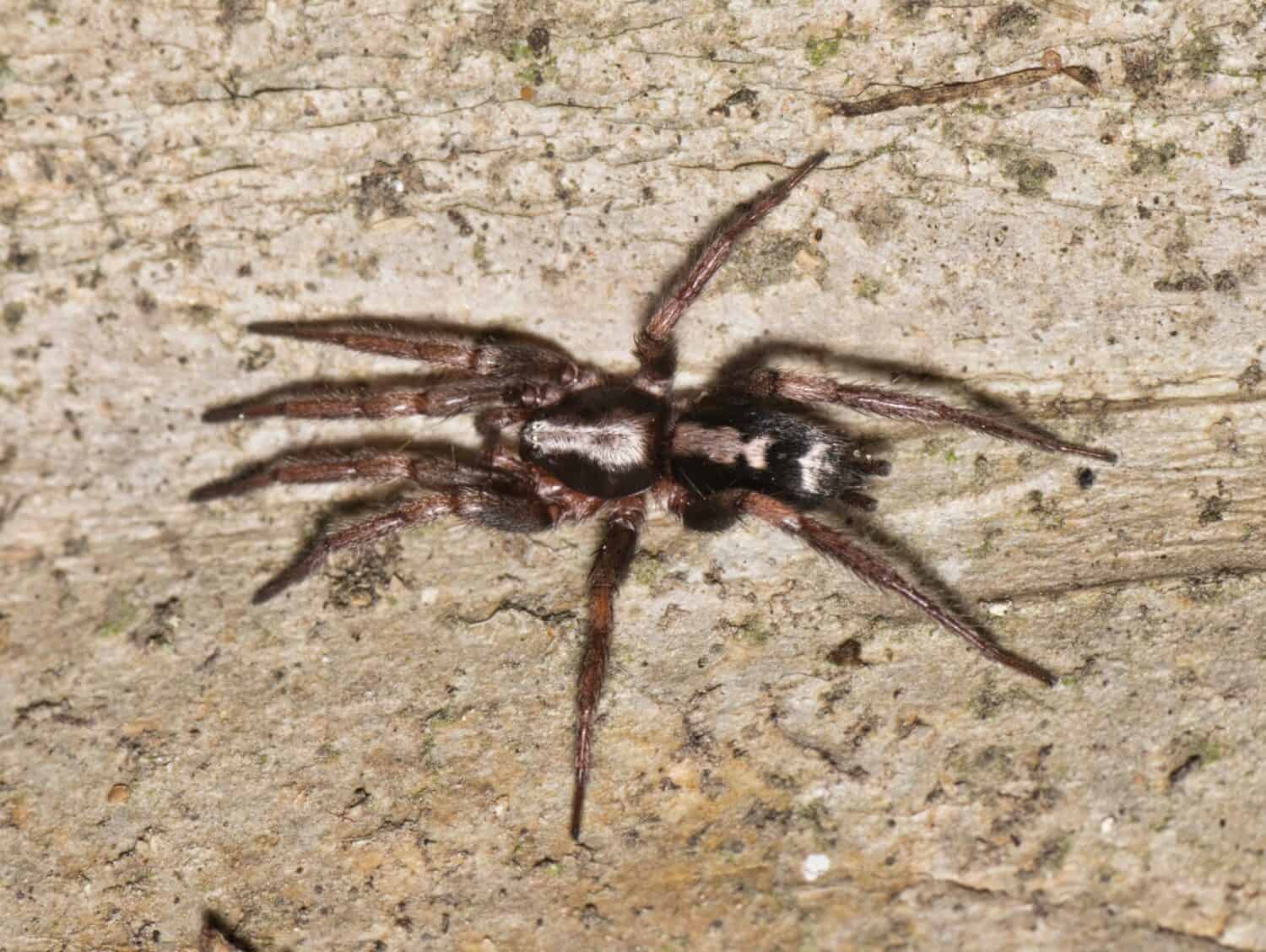
The Parson Spider likes to make its nest inside of rolled leaves, then using its silk, creates closed doors.
©Brett Hondow/Shutterstock.com
Appearance: The Eastern Parsons Spider has flat black hairs on its back and leg segment closest to the body and grey hairs on the cephalothorax. The lower portion of the legs is reddish-brown. The white markings on its abdomen look similar to the clerical collar worn in the seventeenth and eighteenth centuries called a cravat, hence where the spider’s name comes from. It also has a white spot directly above its spinnerets.
Size: Their body is roughly 1/4 – 1/2 inch long with a leg span of 1/2 – 1 inch.
Habitat: They live in wooded areas with plenty of leaf litter, logs, and rocks.
Lifespan: 1 – 2 years
Danger: They are not medically significant.
17. Shamrock Orb Weaver (Araneus trifolium)
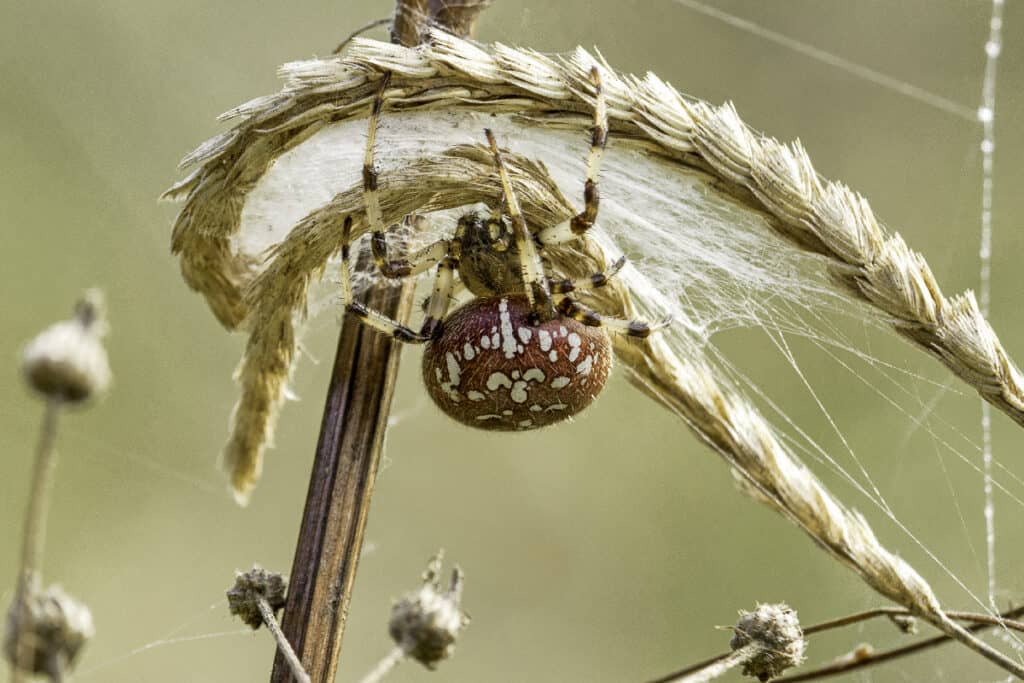
Shamrock orb weavers build webs that measure nearly 2 feet wide and they rebuild it fresh nightly.
©iStock.com/StewartMyers
Appearance: The Shamrock Orb Weaver has brownish-red and white stripes on its legs, which sets them apart from the other orb weavers. Their body can come in a wide array of colors, most notably; peach, light green, orangy-beige, white and brown.
Size: The body length of this spider can be 3/4 inch while the leg span can be 1.5 inches. When frightened, they tuck their legs under their body, making them easy to overlook.
Habitat: The edge of wooded areas among brush and shrubs is where they stretch their webs across. They like to stick close to humid areas to drink the moisture that builds up on their webs, like morning dew.
Lifespan: 1 year
Danger: They are not medically significant and pose no threat to humans.
18. Paradise Jumping Spider (Habronattus americanus)

The male Paradise Jumping Spider is named such for its bright coloring. The female as pictured above, is not brightly colored.
©Paul Reeves Photography/Shutterstock.com
Appearance: The female Paradise Jumping Spider is brown, grey, and fuzzy. They are larger than the males. Conversely, the males are quite the lookers with red chelicerae and red on their legs. They also have a bluish band across the bottom part of their face.
Size: 1/4 inch and 3/4 inch leg span
Habitat: As arboreal spiders, they tend to climb high into plants and trees. They can also commonly be found on fences, houses, bricks, and other buildings, even in children’s playhouses.
Lifespan: 1 – 3 years, with males only living 1 year
Danger: They do not bite humans, and they are not medically significant
19. Zebra Jumping Spider (Salticus scenicus)
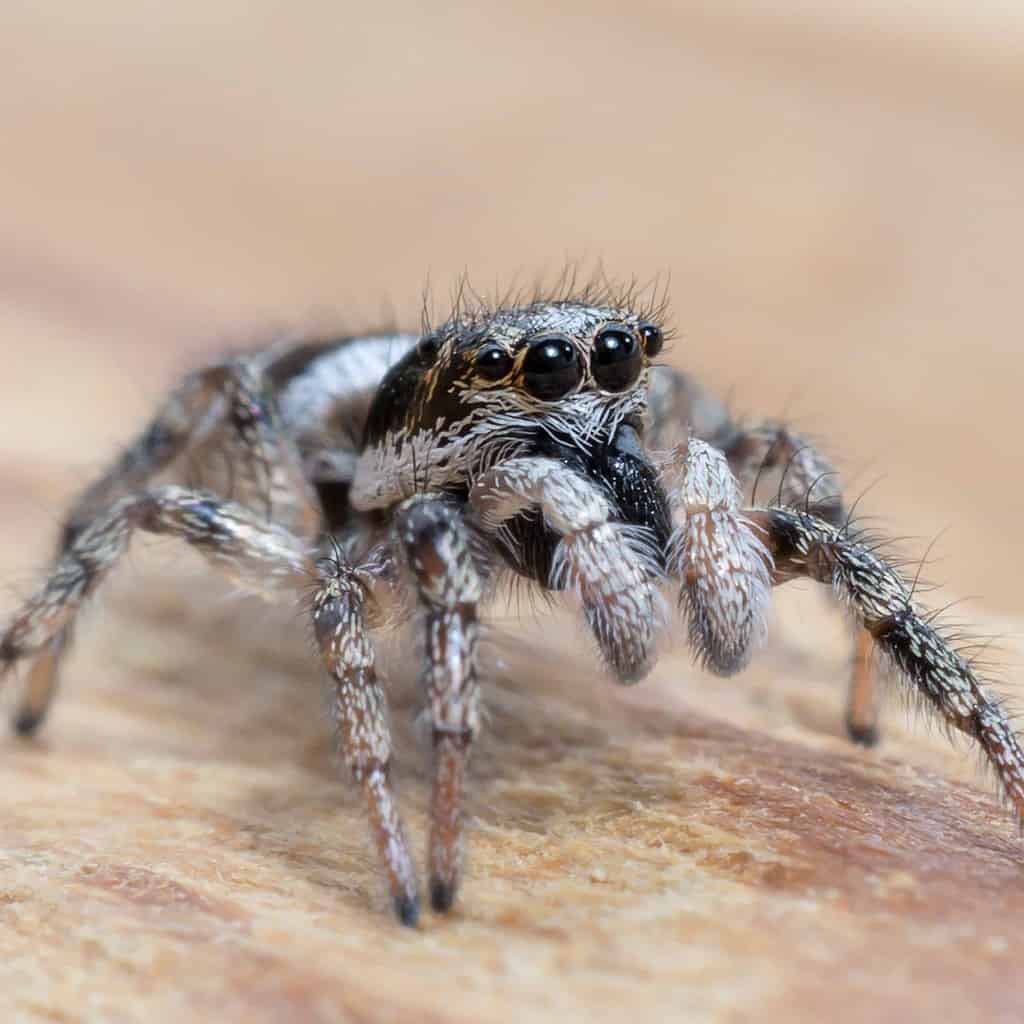
A Zebra Jumping Spider female hunts on foot instead of using a web.
©Photographer: Rabanser/Shutterstock.com
Appearance: Both male and female spiders have black and white stripes, which give them their namesake’s look. Sometimes the black can look brown, and the females tend to have more white on their bodies. Their chelicerae can be a range of bright colors, which is especially noticeable in males. The females have very fluffy pedipalps. They also have large forward-facing eyes that allow them almost perfect 360 vision.
Size: 1/8 – 1/4 inch in length with a leg span of 1/4 – 1/2 inch
Habitat: They prefer to live high up as arboreal spiders in trees, buildings, fences, children’s playhouses, bushes, and gardens. Sometimes they sneak inside and make great roommates that eat mosquitos and flies.
Lifespan: 1 – 3 years
Danger: They are harmless to humans and pose no medically significant threat.
20. Tuberculated Crab Spider (Tmarus angulatus)

The Tuberculated
Crab Spider
gets its name from its sideways walk and the way it holds four legs in a crab-like pose.
©RealityImages/Shutterstock.com
Appearance: These strange little spiders look like tiny octopuses. They lay with their legs stretched out to mimic the inside of flowers, plants, and stalks. The crab spider can be brown, orange, green, or a combination of those colors.
Size: 1/8 to 1/4 in length with a leg span of
Habitat: Like most other crab spiders, these spiders prefer to hunt prey by camouflaging themselves on the tops of flowers or stems of plants. They may even stretch across from stem to stem, mimicking one.
Lifespan: 1 year
Danger: Not dangerous to humans and poses no medical significance.
21. Stealthy Ground Spider (Sergiolus montanus)
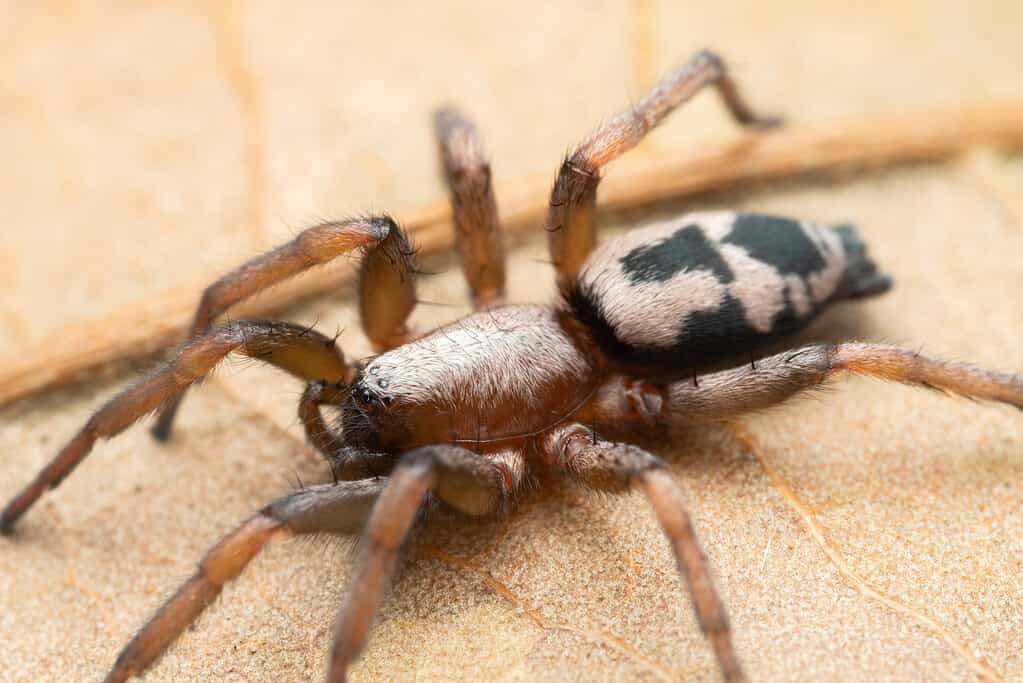
The Stealthy Ground Spider is very small and is easily overlooked.
©Marshal Hedin from San Diego, USA, CC BY-SA 2.0 via Wikimedia Commons – License
Appearance: They have a black to reddish-brown exoskeleton with a black/brown and white/beige striped abdomen. They are oblong-shaped and may mimic velvet ants with their loud markings.
Size: 1/8 – 1/4 inch long with a leg span of 1/4 – 1/2 inch.
Habitat: These spiders prefer to hide in wooded areas, leaf litter, brush, bushes, and sometimes on trees though they generally stick to the ground. They are more commonly seen than nocturnal spiders but are very timid.
Lifespan: 1 – 3 years
Danger: They are harmless to humans and do not pose any significance medically.
22. Bronze Jumping Spider (Eris militarist)
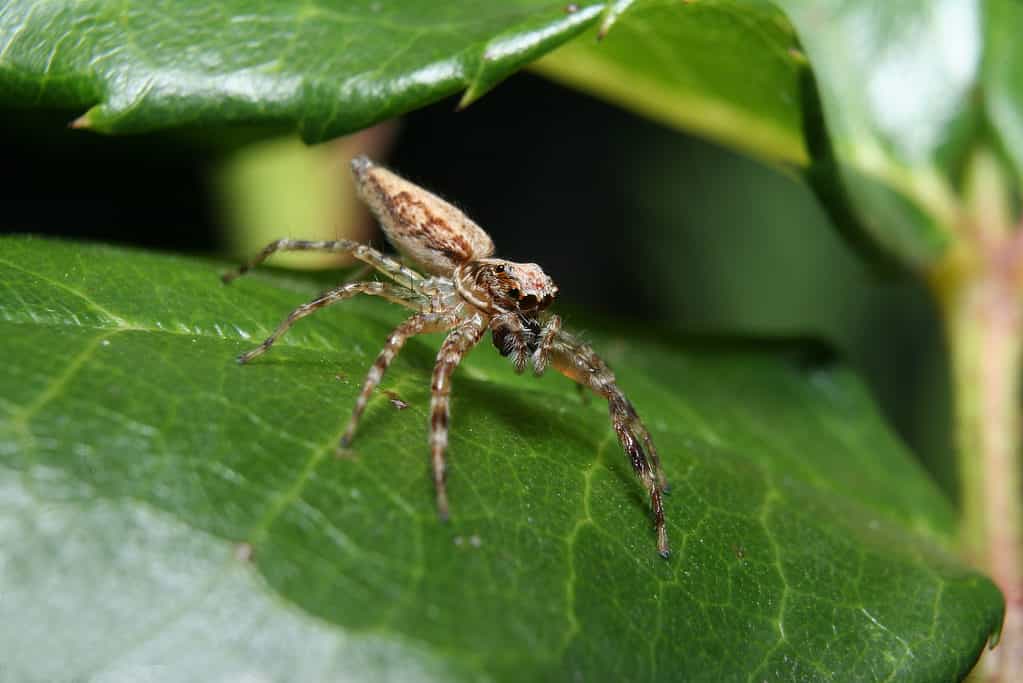
Bronze Jumping Spiders can leap several inches, which is more than 10 times their size.
©iStock.com/Andrew Waugh
Appearance: This tiny jumping spider has a light brown body decorated with darker brown designs and white and brown striped legs.
Size: 1/8 – 1/4 inch in length with a leg span of 1/4 – 1/2 inch
Habitat: They prefer climbing walls, fences, trees, houses, and outdoor structures. The spider makes tiny hammocks to sleep in at night but hunts on foot.
Lifespan: 1 – 3 years
Danger: They do not pose any threat to humans.
23. Long-Jawed Cave Orbweaver (Meta ovalis)
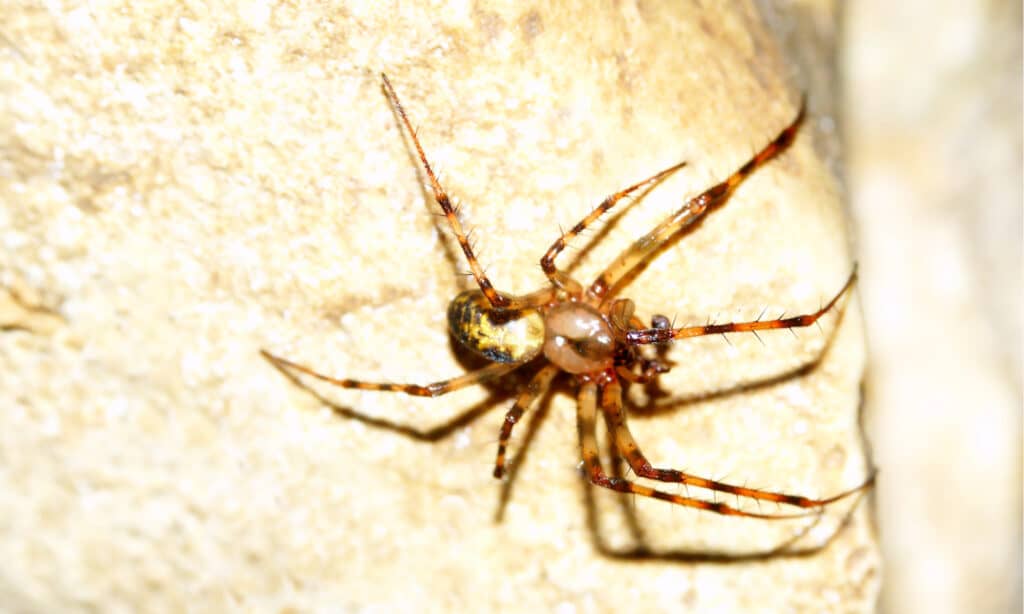
Long-Jawed Cave Orb Weavers do not have long jaws or even long legs.
©Jason Patrick Ross/Shutterstock.com
Appearance: Orb weavers traditionally have legs covered in spines, and the Long-Jawed Cave variety is no different than its relatives. This one also has brown and black striped legs like other orb weavers. The cephalothorax is taupe, and the abdomen is tan-colored with a dark pattern. Sometimes they have an orange or yellowish hue to their abdomen instead of tan. Near the eyes and mouth, the spider is black.
Size: 1/8 inch in length
Habitat: Orb weavers love being in disguise and ambushing their prey. This one, particularly, enjoys its time in caves, basements, old wells, old mines, and very densely shaded areas. The spiders do not live deep in caves but more so at the entrance. They have fully pigmented eyes and coloring. They build their webs from the ceiling vertically to the floor, which is different than the others in their family.
Lifespan: 1 – 2 years
Danger: Not dangerous to humans.
24. Hackled-Mesh Weaver (Callobius bennetti)
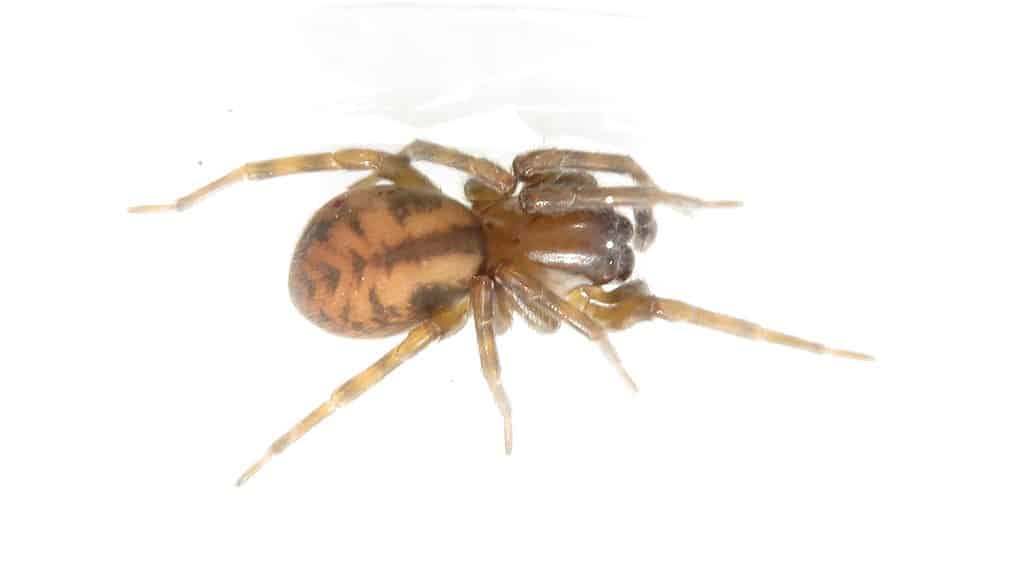
Hackled Mesh Orb Weavers like to sneak into basements to ride out the winter.
©Dan MacNeal / CC BY 4.0 – License
Appearance: As with the other orn weavers, this spider also has legs covered with spines for picking up vibrations since they do not have ears. The legs are also black and brown striped.
Size: 1/8 – 1/4 inch in length
Habitat: These spiders live in damp environments, like; basements, crawlspaces, wood piles, under sheds, rocks, and leaf litter in a heavily shaded area.
Lifespan: 1 – 2 years
Danger: Does not pose any risk to humans.
25. Boreal Tuft Jumping Spider (Phidippus borealis)

The Boreal Jumping Spider has tiny dots of gold along each segment of its legs to match the golden-colored decoration on their abdomen.
©Claude Nozères / CC BY 4.0 – License
Appearance: This small-bodied jumping spider is predominantly black with lots of fuzz, giving it a cute, lovable look. The back is decorated with an ornate orangish-gold with black running down the center of the abdomen. The chelicerae can be seen in many colors and change with each molt.
Size: 1/4 inch in length
Habitat: They will likely be seen on the walls of outdoor structures, houses, fences, gardens, and trees in warmer temperatures.
Lifespan: 1 – 3 years
Danger: Love at first sight; otherwise, no known threat to humans.
26. Star-Bellied Orb Weaver (Acanthepeira stellata)

The Starbellied Orb Weaver gets its name from the star shape found when connecting the points on its abdomen.
©Judy Gallagher, CC BY 2.0 <https://creativecommons.org/licenses/by/2.0>, via Wikimedia Commons – License
Appearance: This spider almost looks like a tiny dinosaur with all of its spikes along its sides and back. This is where their namesake lies; in the 10 – 12 pointed star shape that makes up their “back” or abdomen. Two of their eight eyes are set on two points. Their brownish-orange colored head is covered with fine white hairs. The legs are spiny and faintly brown and brownish-orange striped.
Size: 1/4 – 1/2 inch in length
Habitat: They tend to build their 10-inch cartwheel webs between tree trucks or bushes up high enough to catch the maximum amount of insects. They stick to the edge of meadows and woodlands.
Lifespan: 1 – 2 years
Danger: None whatsoever to humans.
27. California Jumping Spider (Platycryptus californicus)

The California Jumping Spider has two large and two small forward-facing eyes, which give it excellent vision.
©Ernie Cooper/Shutterstock.com
Appearance: The jumping spider is small and quick when it needs to be. They are black or dark grey throughout their body with an attractive zigzag design in lighter grey on their back or abdomen. Their pedipalps are fuzzy like their body. The male’s chelicerae are bolder than the females, but both can have brightly colored “teeth” in various colors.
Size: 1/4 – 1/2 inch in length
Habitat: These jumpers can be found on walls, outside homes, garages, other outdoor structures, trees, gardens, and bushes. They make small hammocks in which they sleep and otherwise only use their webbing for egg sacs and molting chambers.
Lifespan:1 – 3 years
Danger: None to humans.
28. American Folding Trapdoor Spider (Hexura picea)
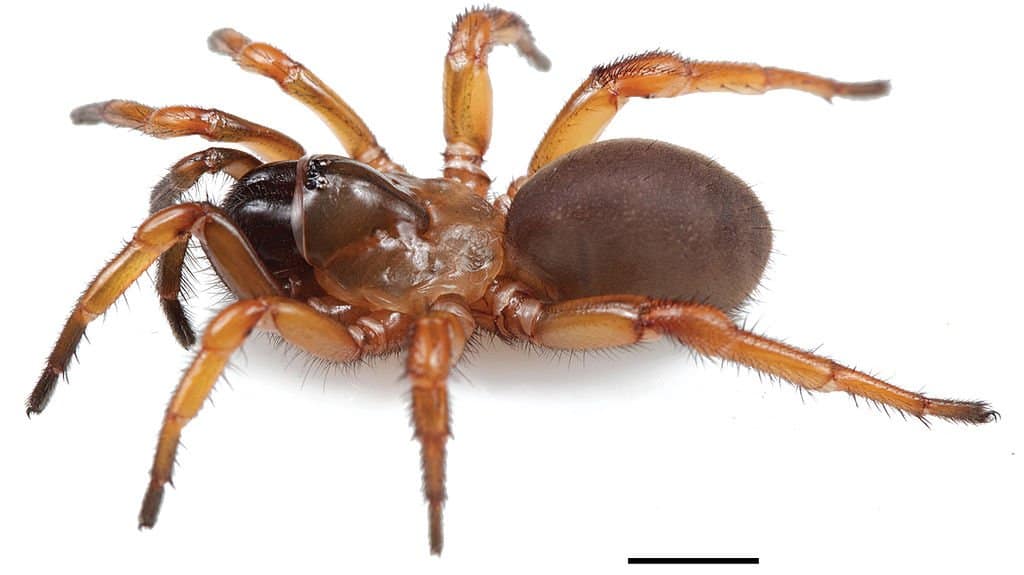
Not an actual photo of the folding trapdoor spider, though it looks similar.
©Jason E. Bond / Creative Commons – License
Appearance: The trapdoor spider is called a mini tarantula but isn’t. They look like tarantulas with their loudly segmented legs and flat cephalothorax. These spiders are reddish-brown and have spines on their legs. They are very timid and stay in the burrows unless looking for a mate or when pulling prey into their tunnel.
Size: Up to 1/2 inch in length
Habitat: They prefer to dig their tunnels in mossy areas, soft ground in wooded and shaded areas, and far from human traffic. These spiders tend to live only in old-growth forests.
Lifespan: 5 – 20 years
Danger: Not dangerous to humans.
The photo featured at the top of this post is © Paul Reeves Photography/Shutterstock.com
Thank you for reading! Have some feedback for us? Contact the AZ Animals editorial team.






